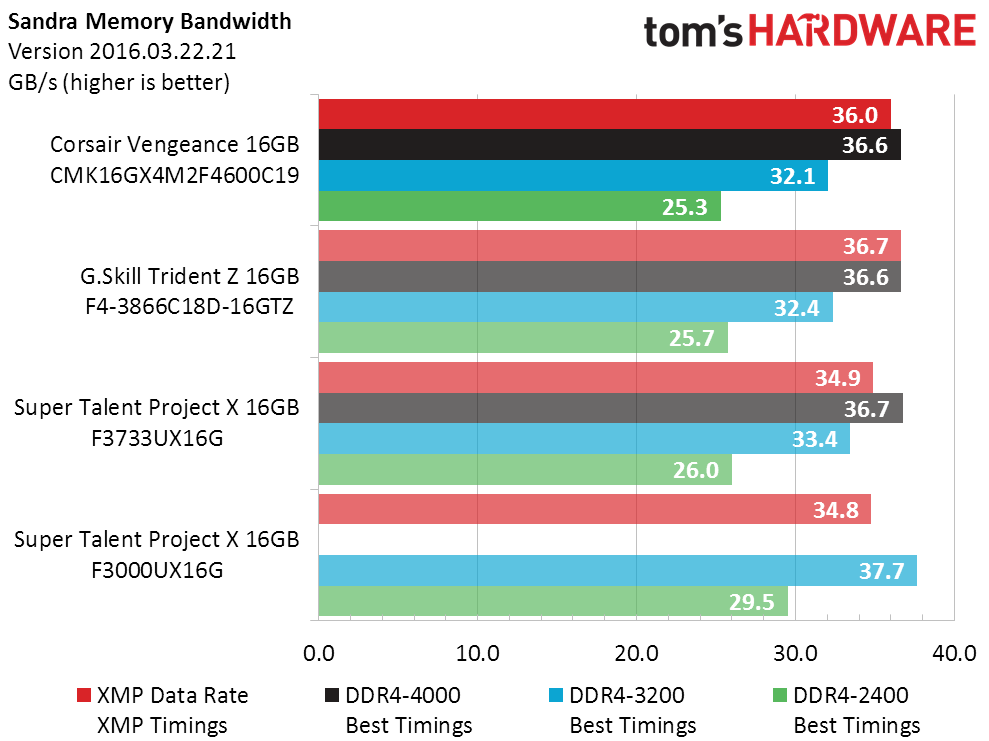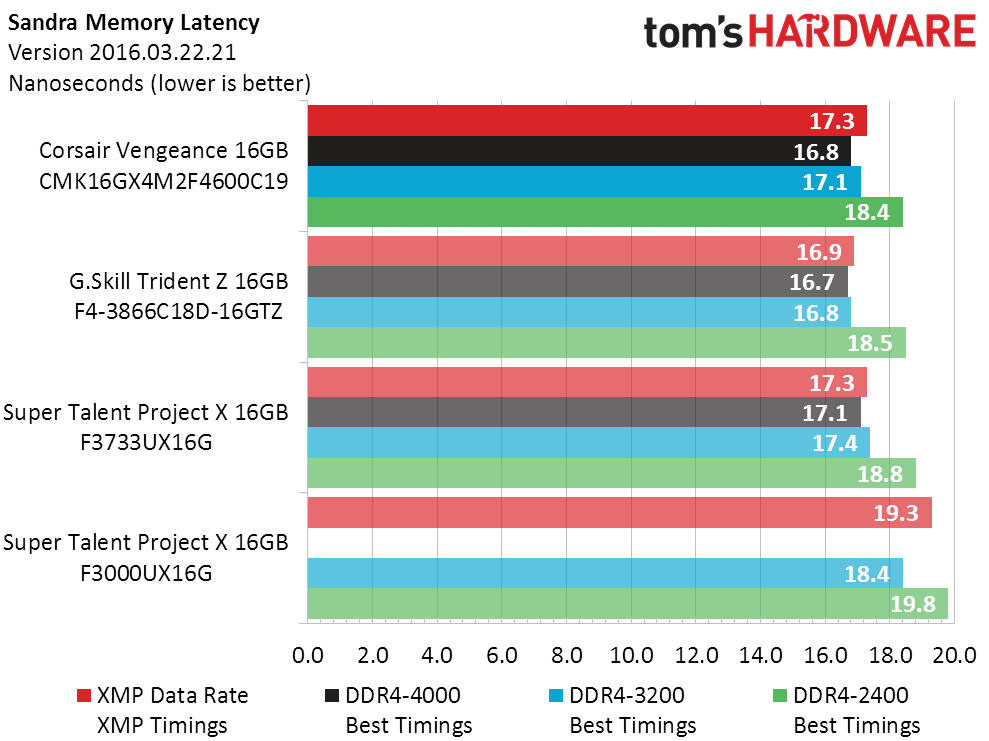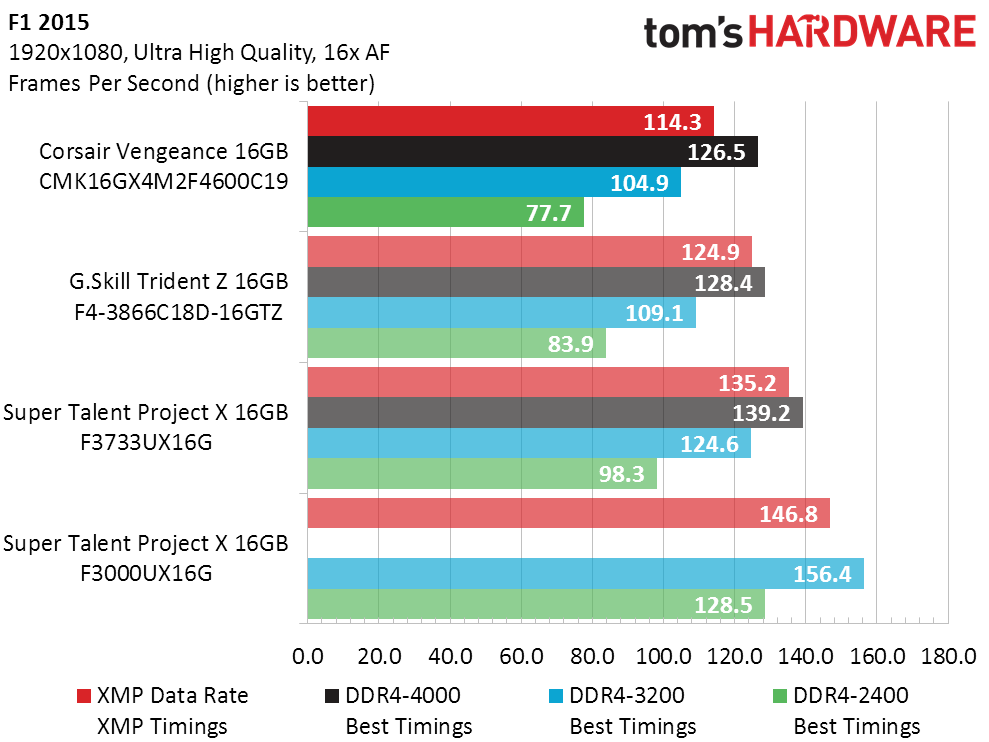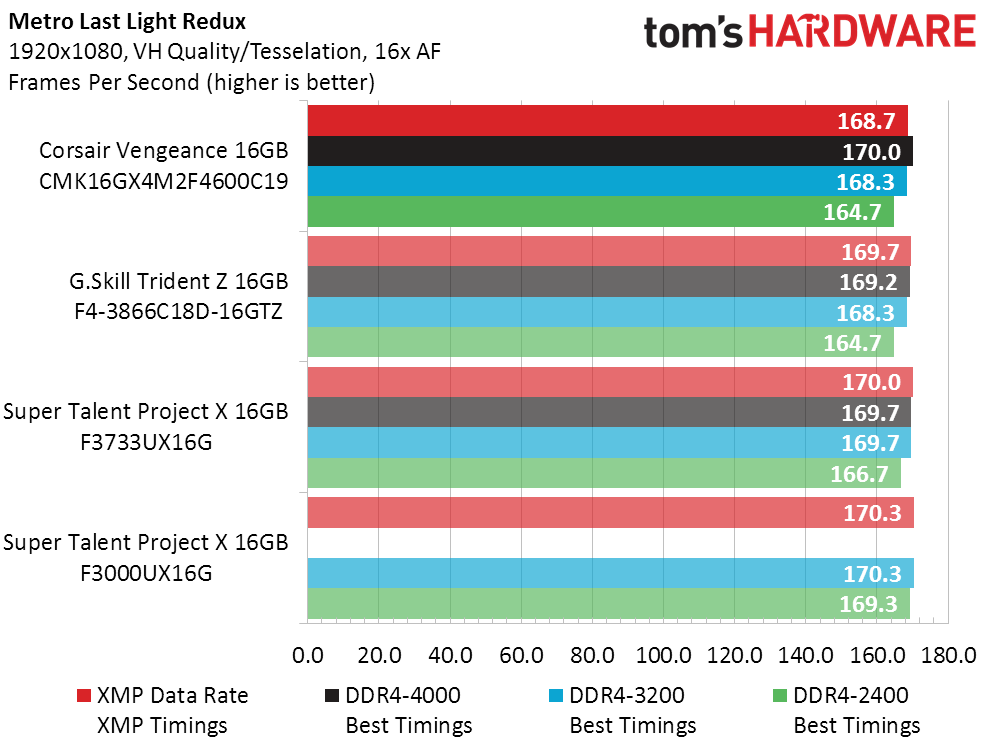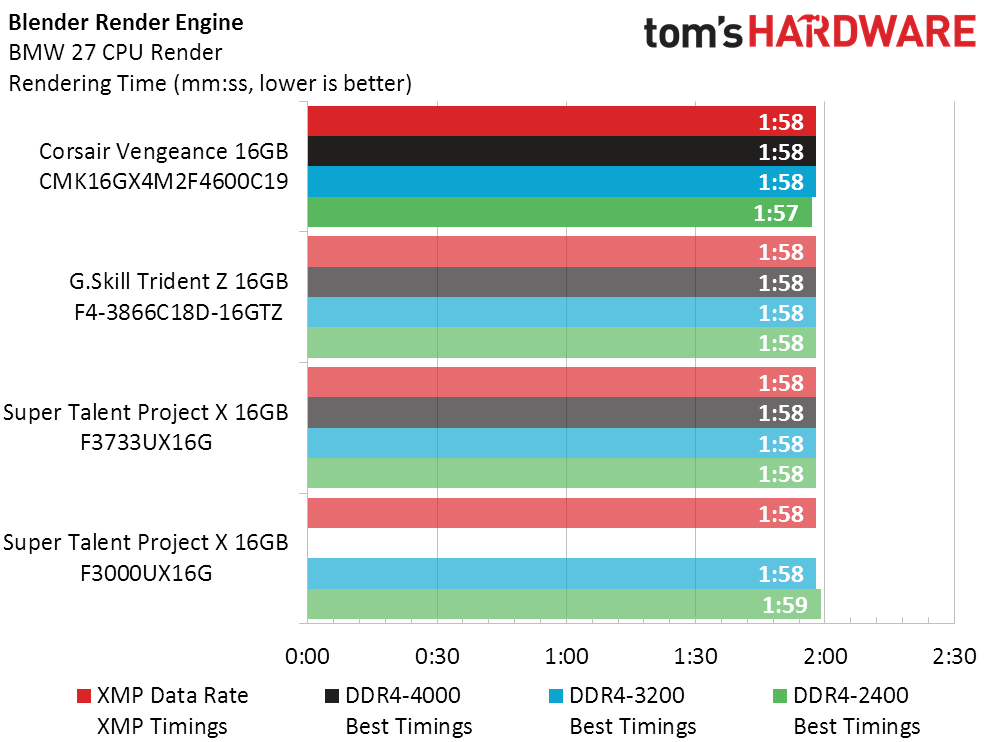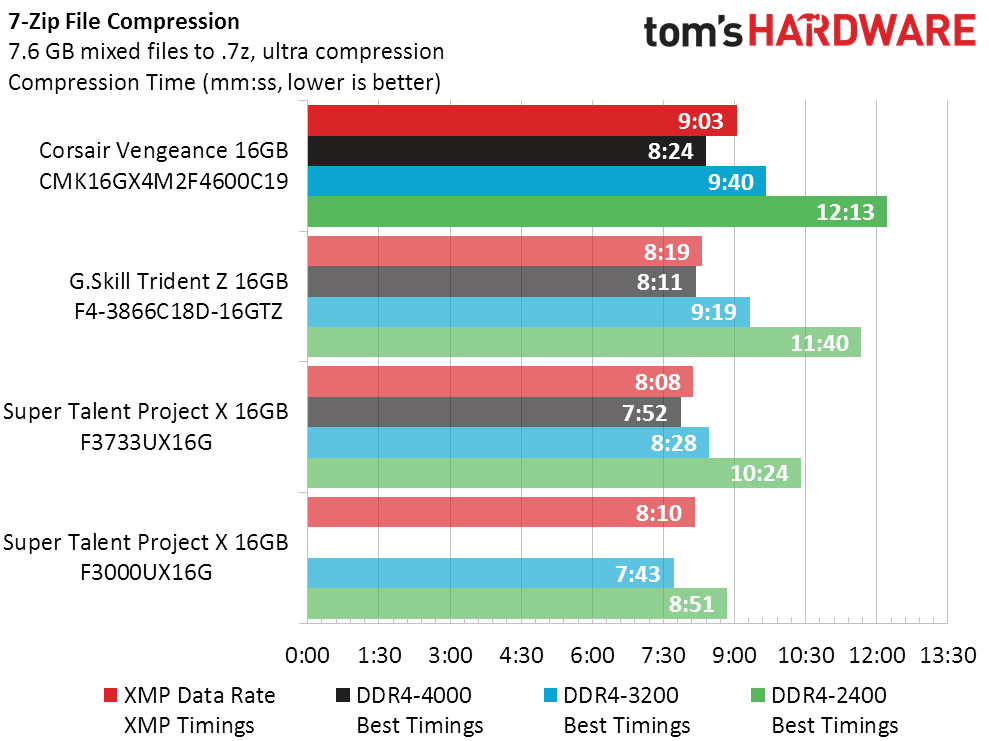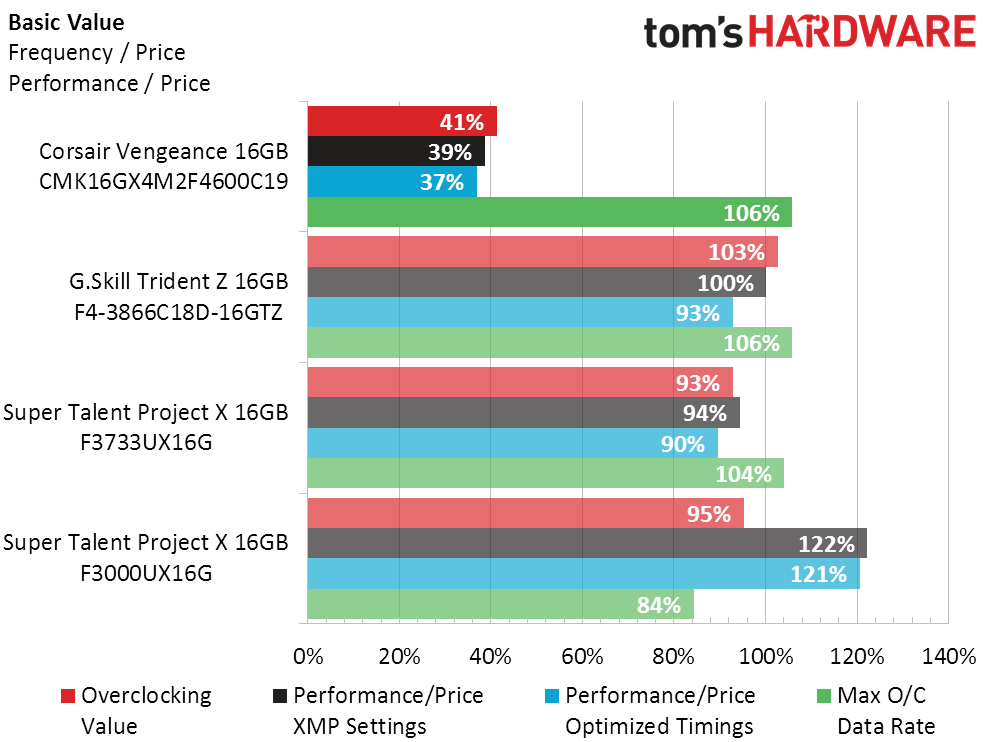Corsair Vengeance LPX 16GB DDR4-4600 Review
Why you can trust Tom's Hardware
Benchmark Results & Final Analysis
We began testing by first establishing the lowest stable timings for each module set. The MSI Z370I Gaming Pro Carbon AC supported tighter latencies than some previous boards, but often required a higher command rate. The G.Skill modules worked at either 15-16-16-32 timings at 1T or 14-14-14-28 timings at 2T, and our tests showed that it performed better at the lower latencies despite the higher command rate.
| Lowest Stable Timings at 1.35V (Max) on MSI Z370I Gaming Pro Carbon AC (BIOS 1.10) | |||
|---|---|---|---|
| Row 0 - Cell 0 | DDR4-4000 | DDR4-3200 | DDR4-2400 |
| Corsair Vengeance 16GB CMK16GX4M2F4600C19 | 18-18-18-36 (2T) | 14-14-14-28 (2T) | 11-11-11-28 (1T) |
| G.Skill Trident Z 16GB F4-3866C18D-16GTZ | 18-18-18-36 (2T) | 14-14-14-28 (2T) | 11-11-11-28 (1T) |
| Super Talent Project X 16GB F3733UX16G | 19-19-19-38 (2T) | 14-14-14-28 (1T) | 11-12-12-28 (1T) |
| Super Talent Project X 16GB F3000UX16G | X | 15-16-16-32 (1T) | 11-12-12-28 (1T) |
I added DDR4-4000 to today’s test, since three of the four modules supported it. And, since I’m shooting for DDR4-4600 in the O/C test, I also increased the latency ceiling to CAS 23. For the manual overclocking test, I decided to adhere to Intel’s stated 1.35V limit.
Surprisingly, the G.Skill DDR4-3866 and the Corsair DDR4-4600 both reached the same DDR4-4267 data rate when limited to 1.35V. Loosened timings allow the G.Skill modules to exceed the data rate found in the motherboard’s test, and I also found no overclocking benefit to setting the CAS Latency higher than 21-cycles.
The Vengeance LPX DDR4-4600 produced higher bandwidth at DDR4-4000 C18 than at its XMP rating, but part of that could be due to the file sizes Sandra uses during this measurement. Sandra Memory Bandwidth is affected by latency, so let’s see what’s going on there.
CAS latency is measured in cycles, and the cycle time is shorter at higher frequencies, yet the DDR4-4600 could use far fewer latency cycles at the reduced data rate. All three of the super fast memory kits reached their best combination of cycle time vs latency cycles at DDR4-4000.
Get ready for a big surprise! Our analysis of dual-rank DIMMs showed that Intel’s mainstream platforms work best with at least four ranks employed, and that getting there required either four single-rank or two dual-rank DIMMs. F1 2015 is known for being bottlenecked by both the CPU and RAM, so increasing the CPU clock to 4.80 GHz in today’s test allowed the four-rank advantage of two dual-rank DIMMs to be excessively pronounced. It gets worse for the single-rank pairs when I look at my notes and find that, at DDR4-3200, the minimums were 71.4, 77.5, 86.6, and 113.0 FPS, in that order, for the four sets shown.
We saw in a prior review that extremely bad memory timings can cause noticeable differences in Metro Last Light, but those extremes don’t exist when all four of these kits are optimized.
Get Tom's Hardware's best news and in-depth reviews, straight to your inbox.
What I said about Metro also applies to Blender. Both applications are retained in memory evaluations because they’re real-world indicators of how a wide variety of applications respond to only the most drastic changes in memory performance. To wit: These apps help us maintain a real-world perspective.
Remembering that less is more when it comes to task completion times, a pair of dual-rank DDR4-3000 cleans the floor with its single-rank modules at most data rates. Data rate still helps though, as illustrated in the difference between that set’s default DDR4-3000 performance and its DDR4-3200 overclocked performance.
Bragging rights appear to be the primary reason people pay big bucks for DDR4 tested beyond 4000MT/s, so the value chart really doesn’t apply. On the other hand, people looking for the best performance per dollar can use it as a club against braggarts.
MORE: Best Memory
MORE: DDR DRAM FAQs And Troubleshooting Guide
MORE: All Memory Content
-
barryv88 Ok correct me if I'm wrong, but it seems that the Super Talent F3200 kit smokes everything in terms of overall performance and at the same time, costs only 129 bucks. Seems like a bargain to me.Reply -
none12345 Am i missing something? The cheapest and lowest rated ram of the comparison is the fastest?Reply
Why even sell 4600 if its slower then 3200. -
Wisecracker Reply
I would urge caution in sweeping generalizations (in a limited 'Corsair' review) while noting the F3000UX16G first numbers are impressive in this instance.20668211 said:Ok correct me if I'm wrong, but it seems that the Super Talent F3200 kit smokes everything in terms of overall performance and at the same time, costs only 129 bucks. Seems like a bargain to me.
I'll also note that the F3000UX16G kit is the only (?) dual-rank set, and a DDG search did not find any in stock -- and where listed were priced from $186 to $200.
That said, here's hoping the fine folks at THG can pull together the AM4+ components for a test-drive of a new RyZen APU at similar levels. Make it so, Corsair!
-
alex0826 $549 for 16 gigs of ddr4 RAM, granted it's high-speed Ram, but really? Who's drug habits are we supporting? They are out of their tree, not to mention the cost of a 1950x CPU and a $400 motherboard to go with it, wow! And this Hardware combined is not even a fraction of a Quantum computer. Of course we're talking about two different leagues but still I had to throw in that stupid analogy. What I'm trying to say is mainstream consumer PC Hardware whether it be enthusiastic class or not seems to be getting pricier over the recent years. Yuck! I think companies and manufacturers alike should all get on the same page and keep their prices really low. That way consumers will have a connection fit and name their first born after that company LOL. Mainly I'm complaining because I can't afford to build the threadripper rig I would surely like to build to replace the FX 9590 I've had for a number of years.:-(Reply -
alex0826 There should be an option to edit what you've posted like other forms allow. I said conniption fit but something else came out LOLReply -
panathas Reply20668688 said:There should be an option to edit what you've posted like other forms allow. I said conniption fit but something else came out LOL
All comments can be edited. You just need to get to the forums in order to do it. Click the COMMENT FROM THE FORUMS link in the upper right part of the comments section. -
Crashman Reply
We originally presented Super Talent's dual-rank DIMMs as an alternative to the T-Force Dark ROG memory reviewed here:20668548 said:
I would urge caution in sweeping generalizations (in a limited 'Corsair' review) while noting the F3000UX16G first numbers are impressive in this instance.20668211 said:Ok correct me if I'm wrong, but it seems that the Super Talent F3200 kit smokes everything in terms of overall performance and at the same time, costs only 129 bucks. Seems like a bargain to me.
I'll also note that the F3000UX16G kit is the only (?) dual-rank set, and a DDG search did not find any in stock -- and where listed were priced from $186 to $200.
That said, here's hoping the fine folks at THG can pull together the AM4+ components for a test-drive of a new RyZen APU at similar levels. Make it so, Corsair!
http://www.tomshardware.com/reviews/teamgroup-dark-rog-16gb-ddr4-3000,4997.htmlThe T-Force Dark ROG is available for $192 at Newegg.
-
jgunn2 If the DDR4-4600 Corsair RAM is advertised at 4600mhz with a requirement of 1.5V to reach this speed, why is it compared to other RAM sets only being tested at 1.30V? Am I missing something? Why was its full potential not tested vs. the full potential of the competition? Why is there no posted performance data based on the Cosair advertised specs? Kind of like buying a V6 but taking 2 cylinders out and then expecting it to perform better than a cheaper car specifically optimized as an inline 4...Reply -
Crashman Reply
First of all, it's 1.35V. Take a look at the top of this chart:20669084 said:If the DDR4-4600 Corsair RAM is advertised at 4600mhz with a requirement of 1.5V to reach this speed, why is it compared to other RAM sets only being tested at 1.30V? Am I missing something? Why was its full potential not tested vs. the full potential of the competition? Why is there no posted performance data based on the Cosair advertised specs? Kind of like buying a V6 but taking 2 cylinders out and then expecting it to perform better than a cheaper car specifically optimized as an inline 4...
We set the 1.35V test limit back when people were having trouble with memory controller damage from higher-voltage RAM. The workaround was to increase the memory controller voltage in order to reduce the voltage difference between the memory controller and the memory signal, but we never employed it. Yet some manufacturers have figured out that some motherboards will now use the workaround when configured with 1.50V RAM.
We agreed to test the kit before taking note of its test-violating voltage level. Rather than force a violation out of the other kits, we limited the 1.50V test to DDR4-4600's XMP configuration. If you look at the charts you'll see it performed better at DDR4-4000 with optimized timings than it had at DDR4-4600 using XMP timings? The DDR4-4000 test, like those of the competing modules, was run at 1.35V.

